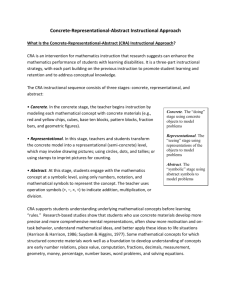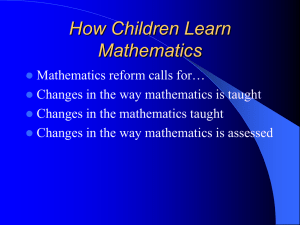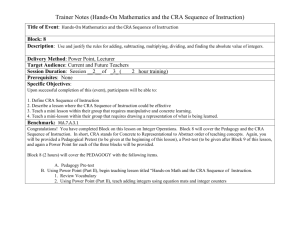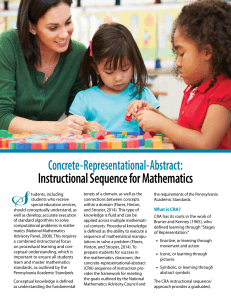EBI-Brief-Template-Concrete-Representational
advertisement
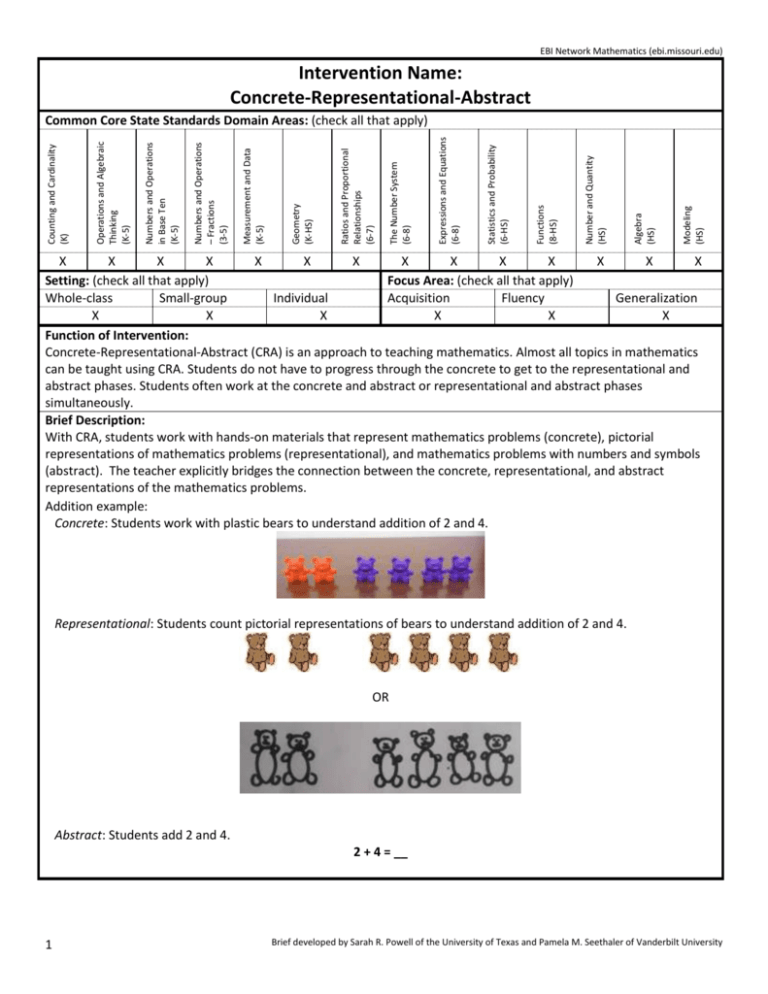
EBI Network Mathematics (ebi.missouri.edu) Intervention Name: Concrete-Representational-Abstract Modeling (HS) Algebra (HS) Number and Quantity (HS) Functions (8-HS) Statistics and Probability (6-HS) Expressions and Equations (6-8) The Number System (6-8) Ratios and Proportional Relationships (6-7) Geometry (K-HS) Measurement and Data (K-5) Numbers and Operations – Fractions (3-5) Numbers and Operations in Base Ten (K-5) Operations and Algebraic Thinking (K-5) Counting and Cardinality (K) Common Core State Standards Domain Areas: (check all that apply) X X X X X X X X X X X X X X Setting: (check all that apply) Focus Area: (check all that apply) Whole-class Small-group Individual Acquisition Fluency Generalization X X X X X X Function of Intervention: Concrete-Representational-Abstract (CRA) is an approach to teaching mathematics. Almost all topics in mathematics can be taught using CRA. Students do not have to progress through the concrete to get to the representational and abstract phases. Students often work at the concrete and abstract or representational and abstract phases simultaneously. Brief Description: With CRA, students work with hands-on materials that represent mathematics problems (concrete), pictorial representations of mathematics problems (representational), and mathematics problems with numbers and symbols (abstract). The teacher explicitly bridges the connection between the concrete, representational, and abstract representations of the mathematics problems. Addition example: Concrete: Students work with plastic bears to understand addition of 2 and 4. Representational: Students count pictorial representations of bears to understand addition of 2 and 4. OR Abstract: Students add 2 and 4. 2 + 4 = __ 1 Brief developed by Sarah R. Powell of the University of Texas and Pamela M. Seethaler of Vanderbilt University EBI Network Mathematics (ebi.missouri.edu) Division with fractional answers examples (adapted from Witzel & Riccomini, 2009): Concrete: Students use manipulatives (i.e., craft sticks and paper cups) to divide 9 sticks into 3 cups “Let’s divide nine sticks into three cups. How many sticks do we have per cup?” Representational: Students draw a picture that represents 9 tallies being divided into 3 groups “Let’s divide nine tallies into three groups. How many tallies do we have per group?” OR Abstract: Students divide 9 by 3. 9/3 = 3 or 9 ÷ 3 = 3 Procedures: Duration: Students work on mathematics problems using CRA for as long as necessary to understand important conceptual and procedural skills related to specific mathematics topics. Teacher training: Teachers must be familiar with hands-on materials and how to introduce the materials and use them with the students. Many hands-on materials can be used to teach multiple mathematics skills. For example, Base-10 blocks can be used for whole number computation as well as decimal computation. Teachers must also understand how to teach the connection between C and R and A. Instructional practices: Teachers should introduce concepts with concrete materials or representations so students gain conceptual understanding of different mathematics principles and procedures. Teachers should connect the concrete and representational to the abstract as early as possible. Monitoring system: Teachers should conduct formal and informal assessments of student learning while at any stage of CRA. Students may progress through the CRA sequence at different rates, resulting in some students needing more time at the concrete or representative levels. Critical Components (i.e., that must be implemented for intervention to be successful): Teachers must choose appropriate hands-on materials and pictorial representations to represent the abstract problems. Teachers must provide appropriate instruction on using the hands-on materials. Critical Assumptions (i.e., with respect to prerequisite skills): When teachers are introducing a new skill, teachers must ensure students have established prerequisite skills. (For example, when teaching fraction computation, students should already understand whole number computation and have basic fractions skills of understanding numerator and denominator.) 2 Brief developed by Sarah R. Powell of the University of Texas and Pamela M. Seethaler of Vanderbilt University EBI Network Mathematics (ebi.missouri.edu) Materials: Hands-on materials can be purchased from teacher stores or mathematics manipulatives companies. Handson materials can also be household materials (e.g., beans, apples, pasta noodles) or classroom materials (e.g., paperclips, crayons, stickers, cups, craft sticks). Pictorial representations can often be generated by word-processing programs. The National Library of Virtual Manipulatives (www.nlvm.usu.edu) can be used to supplement hands-on materials if teachers do not have access to all necessary materials. References: Miller, S. P., & Hudson, P. J. (2006). Helping students with disabilities understand what mathematics means. Teaching Exceptional Children, 39(1), 28-35. Witzel, B. S., Mercer, C. D., & Miller, M. D. (2003). Teaching algebra to students with learning difficulties: An investigation of an explicit instruction model. Learning Disabilities Research and Practice, 18, 121-131. Witzel, B. S., & Riccomini, P. J. (2009). Computation of fractions: Math intervention for elementary and middle grade students. Upper Saddle River, NJ: Pearson. 3 Brief developed by Sarah R. Powell of the University of Texas and Pamela M. Seethaler of Vanderbilt University

